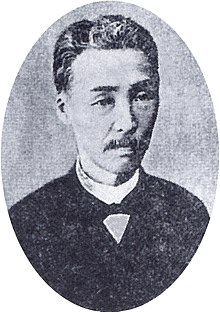In this Japanese name, the surname is Tsugaru.
| ViscountTsugaru Tsugumichi | |
|---|---|
| 津軽承叙 | |
 Tsugaru Tsugumichi after the Meiji restoration Tsugaru Tsugumichi after the Meiji restoration | |
| In office 1851–1868 | |
| Monarchs | Shōgun |
| Preceded by | Tsugaru Tsuguyasu |
| Succeeded by | < position abolished > |
| Imperial Governor of Kuroishi | |
| In office 1869–1871 | |
| Monarch | Emperor Meiji |
| Personal details | |
| Born | (1840-09-24)September 24, 1840 |
| Died | December 7, 1903(1903-12-07) (aged 63) |
| Spouse | 4th daughter of Ikeda Narinori |
| Parent |
|
Tsugaru Tsugumichi (津軽 承叙, September 24, 1840 – December 7, 1903) was the fourth and final daimyō of Kuroishi Domain in northern Mutsu Province, Honshū, Japan (modern-day Aomori Prefecture). His courtesy title was Shikibu-no-shō, and his Court rank under the Tokugawa shogunate was Junior Fifth Rank, Lower Grade.
Biography
Tsugaru Tsugumichi was the son of Tsugaru Yukitomo, from a branch line of the Tsugaru clan, and was adopted by the 3rd daimyō of Kuroishi, Tsugaru Tsuguyasu, as official heir due to the lack of a male descendant on Tsuguyasu’s death in 1851. He changed his name at the time from Tsugaru Tomozumi to Tsugaru Tsugumichi.
Tsugumichi became daimyō during the turbulent Bakumatsu period, during which time the Tsugaru clan first sided with the pro-imperial forces of Satchō Alliance, and attacked nearby Shōnai Domain. However, the Tsugaru soon switched course, and briefly joined the Ōuetsu Reppan Dōmei. However, for reasons yet unclear, the Tsugaru backed out of the alliance and re-joined the imperial cause after a few months, participating in several battles in the Imperial cause during the Boshin War, notably that of the Battle of Noheji, and Battle of Hakodate.
After the Meiji Restoration, with the abolition of the han system, Tsugumichi was appointed Imperial Governor of Kuroishi from 1869 to 1871, at which time the territory was absorbed into the new Aomori Prefecture. He relocated to Tokyo, and with the establishment of the kazoku peerage system in 1882, he was awarded with the title of shishaku (viscount). He became a member of the House of Peers in 1890. In his later years, he was noted for his waka poems. On his death, he was posthumously granted Third court rank. His grave is at the Yanaka Cemetery in Taitō-ku, Tokyo.
See also
References
- The content of much of this article was derived from that of the corresponding article on Japanese Misplaced Pages.
- Koyasu Nobushige (1880), Buke kazoku meiyoden vol. 1 (Tokyo: Koyasu Nobushige), p. 25. (Accessed from National Diet Library Archived February 11, 2010, at the Wayback Machine, July 17, 2008)
- ^ Edwin McClellan and Mori Ōgai. (1985). Woman in the Crested Kimono : The Life of Shibue Io and Her Family Drawn from Mori Ogai's 'Shibue Chusai. New Haven: Yale University Press. p. 175. ISBN 978-0-300-04618-2
- Mark Ravina (1999), Land and Lordship in Early Modern Japan. California: Stanford University Press. pp. 152–153. ISBN 0804763860
- Eikō Onodera (2005). Boshin nanboku sensō to Tōhoku seiken. Sendai: Kita no mori. p. 140.
Further reading
- Kurotaki, Jūjirō (1984). Tsugaru-han no hanzai to keibatsu 津軽藩の犯罪と刑罰. Hirosaki: Hoppō shinsha.
- Narita, Suegorō (1975). Tsugaru Tamenobu: shidan 津軽為信: 史談. Aomori: Tōō Nippōsha.
- Tsugaru Tsuguakira Kō Den kankōkai (1976). Tsugaru Tsuguakira kō-den 津輕承昭公傳. Tokyo: Rekishi Toshosha
External links
- (in Japanese) "Hirosaki-jō" Archived May 26, 2010, at the Wayback Machine (February 17, 2008)
- (in Japanese) "Tsugaru-han" on Edo 300 HTML Archived March 14, 2016, at the Wayback Machine (February 17, 2008)